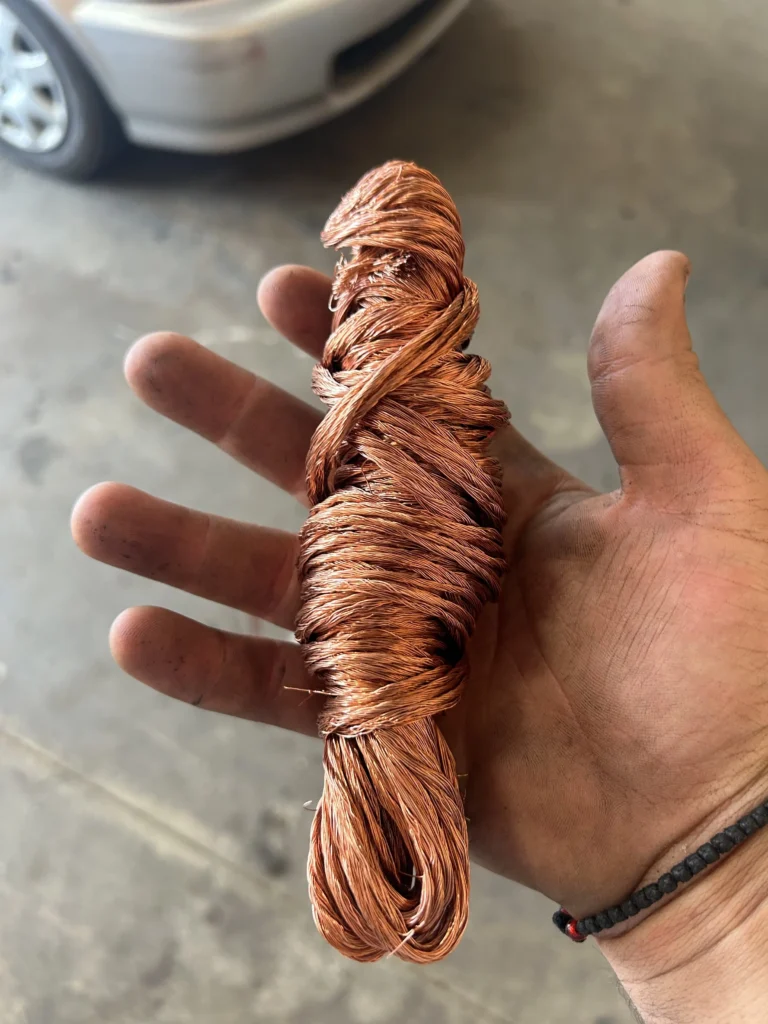How to Identify and Sort Scrap Metal
Recycling scrap metal is not only beneficial for the environment but can also be a lucrative practice if done correctly. One of the first steps in effective metal recycling is being able to identify and sort different types of scrap metal. Whether you’re an individual looking to clear out some old junk or a business dealing with large amounts of scrap, knowing how to identify and sort scrap metal can make a significant difference in the efficiency and profitability of your recycling efforts. In this guide, we’ll walk you through the process of how to identify and sort scrap metal effectively.
Take a look at the picture below. After reading through this guide, you’ll be able to identify that this is copper wiring, one of the most valuable types of scrap metal you can recycle. Understanding how to identify and sort scrap metal is crucial for maximizing the value of your recycling efforts.

Why Proper Identification and Sorting Matters
Knowing how to identify and sort scrap metal is crucial because different metals have different values, and recycling centers often require metals to be sorted before they are accepted. Additionally, certain metals may require special handling due to their properties or the presence of hazardous materials. By knowing how to identify and sort scrap metal correctly, you can:
- Maximize the value of your scrap.
- Ensure safe and efficient recycling.
- Avoid potential fines or rejections from recycling centers.
Step 0: Gather Safety Equipment
Before you start learning how to identify and sort scrap metal, it’s important to prioritize safety. Ensure you have the following safety gear on hand:
- Gloves: Protect your hands from sharp edges and potential cuts.
- Safety Glasses: Prevent metal fragments or dust from getting into your eyes. Learn more about choosing the right safety glasses here.
- Steel-Toe Boots: Protect your feet from heavy or sharp objects.
- Long Sleeves and Pants: Shield your skin from scratches and exposure to metal debris.
Safety should always be your first concern when working with scrap metal to avoid injuries and ensure a smooth sorting process.
Step 1: Gather Your Tools
Before you start sorting, it’s essential to have the right tools on hand. Here’s what you’ll need:
- Magnet: A magnet is your best friend when it comes to identifying metals. Ferrous metals (those containing iron) are magnetic, while non-ferrous metals are not.
- File: A file can help you get a better look at the true color of the metal underneath any coatings or rust.
- Metal Tester Kit: For more advanced identification, consider a metal tester kit, which can help determine the composition of the metal.
Step 2: Start with the Magnet Test
The first and easiest step in sorting scrap metal is to use a magnet:
- Ferrous Metals: If the magnet sticks to the metal, it’s a ferrous metal. Common ferrous metals include steel and iron. These metals are usually less valuable than non-ferrous metals but are still worth recycling.
- Non-Ferrous Metals: If the magnet does not stick, you have a non-ferrous metal. These metals are generally more valuable and include aluminum, copper, brass, and stainless steel.
Step 3: Examine the Color and Weight
Next, take a closer look at the color and weight of the metal:
- Aluminum: Lightweight and silvery in color, aluminum is often found in cans, window frames, and car parts.
- Copper: Copper has a distinct reddish-brown color and is often found in electrical wiring, plumbing pipes, and roofing materials.
- Brass: Brass is yellowish in color and heavier than aluminum but not as heavy as copper. It’s commonly found in fixtures, keys, and musical instruments.
- Stainless Steel: Stainless steel is shiny and silver-colored. It’s non-magnetic or only slightly magnetic and is used in appliances, cutlery, and medical equipment.
Step 4: Conduct a Scratch Test
If you’re unsure about how to identify and sort scrap metal, a scratch test can help. Use a file to scratch the surface of the metal:
- Aluminum: The scratch will reveal a shiny, silver color.
- Copper: Scratching will reveal a reddish color.
- Brass: The scratch will reveal a yellowish color.
- Stainless Steel: The scratch will usually show a bright, silver color, similar to the surface.
Step 5: Sort Your Metals
Once you’ve identified the types of metals, sort them into separate piles:
- Ferrous Metals: Group steel and iron together.
- Non-Ferrous Metals: Create separate piles for aluminum, copper, brass, and stainless steel.
- Specialty Metals: If you come across metals like lead, zinc, or nickel, which are less common, keep them in a separate pile.
Step 6: Prepare for Recycling
After sorting your metals, you’re ready to take them to a recycling center. Some additional tips include:
- Remove Contaminants: Remove any non-metal parts, such as plastic or rubber, from your metals.
- Bundle Smaller Pieces: If you have small pieces of metal, consider bundling them together to make them easier to handle.
Conclusion
Understanding how to identify and sort scrap metal is a key step in the recycling process. Not only does it ensure that you get the most value out of your scrap, but it also helps make the recycling process more efficient and environmentally friendly. At EcoMetals, we make it easy for you to recycle your metals responsibly. Whether you’re dealing with a small amount of household scrap or large quantities from a business, knowing how to identify and sort scrap metal correctly can make a big difference. Our scrap metal pickup services are designed to help you contribute to a sustainable future. If you need more help on how to identify and sort scrap metal, reach us here.
